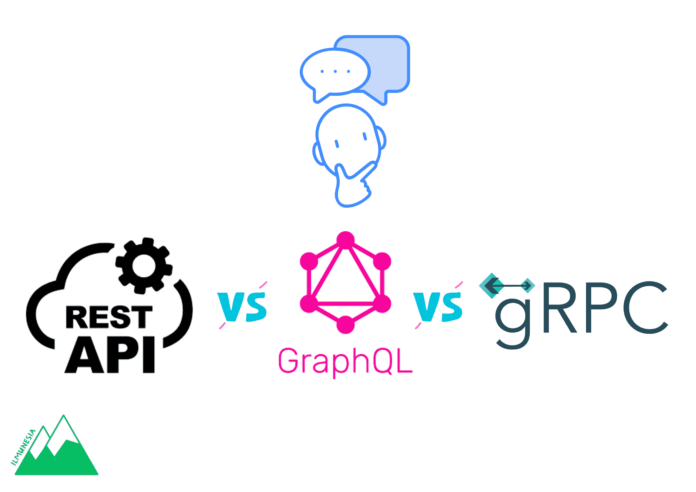As an API developer, choosing the right technology for your project is critical for performance, scalability, and maintainability. REST, GraphQL, and gRPC are three of the most popular API development technologies today, each with its own unique set of features and benefits. In this article, we will provide an in-depth comparison of these technologies, covering performance, pros and cons, use cases, and guidance on how to select the right technology for your specific needs.
Table of Contents

1. REST: Representational State Transfer
REST is a widely adopted architectural style for creating web-based APIs. It relies on standard HTTP requests (GET, POST, PUT, DELETE) and is known for its simplicity and scalability. Key characteristics of REST include:
- Statelessness: Each API request contains all necessary information for the server to process it.
- Client-Server Separation: The client and server are independent, promoting modularity.
- Cacheability: Responses can be cached to improve performance.
- Layered System Architecture: RESTful systems can have multiple layers, enhancing scalability and security.
- Uniform Interface: Standardized use of HTTP methods and URLs.
2. GraphQL: Query Language for APIs
GraphQL, developed by Facebook, is a flexible query language for APIs. It allows clients to request only the data they need, reducing over-fetching and under-fetching. Core principles of GraphQL include:
- Strongly-Typed Schema: Defines data types and relationships, ensuring clear contracts between client and server.
- Hierarchical Data Structure: Mirrors the structure of the data, making it intuitive to work with.
- Client-Driven Queries: Clients specify exactly what data they need.
- Single Endpoint: All interactions occur through a single endpoint, simplifying API design.
3. gRPC: High-Performance API Development
gRPC, created by Google, is designed for high-performance API development. It uses Protocol Buffers for efficient data serialization and HTTP/2 for transport, making it faster and more scalable than REST. Key features of gRPC include:
- Protocol Buffers Serialization: Efficient binary encoding reduces message size.
- Strongly-Typed Contracts: Services and messages are defined using Protocol Buffers.
- Bi-Directional Streaming: Supports real-time communication.
- Language-Agnostic: Supports multiple programming languages through generated client libraries.
4. Performance Comparison
Performance is a crucial factor when choosing an API technology. Here’s how these technologies compare:
- REST: Typically slower for large data sets due to verbose JSON or XML payloads and HTTP/1.1 overhead.
- GraphQL: More efficient than REST because clients request only the necessary data, but can suffer from complex query resolution.
- gRPC: The fastest of the three, thanks to HTTP/2 transport and compact Protocol Buffers serialization.
5. Pros and Cons
REST
Pros
- Easy to learn and widely used.
- Simple caching mechanisms.
- Language and platform agnostic.
Cons
- Less flexible data retrieval compared to GraphQL.
- Slower performance for large data transfers.
- No explicit schema, making it harder to understand data requirements.
GraphQL
Pros
- Flexible and efficient for complex data requirements.
- Clear data requirements due to the strongly-typed schema.
- Reduced data transfer through precise queries.
Cons
- More complex than REST, with a steeper learning curve.
- Limited community support compared to REST.
- Potential for performance bottlenecks with complex query resolution.
gRPC
Pros
- High performance and scalability.
- Strongly-typed contracts ensure clear interfaces.
- Efficient binary data encoding.
Cons
- Requires knowledge of Protocol Buffers.
- Less widely adopted and supported compared to REST and GraphQL.
- More complex setup and tooling requirements.
Must read: 10 Critical Differences: RabbitMQ vs. Kafka vs. ActiveMQ
6. Use Cases
REST
- Simple CRUD Operations: Ideal for basic create, read, update, delete operations.
- Web Applications Requiring Caching: Beneficial for applications where response caching can significantly improve performance.
- Large Data Sets with Infrequent Updates: Suitable for applications like static file servers or public APIs.
GraphQL
- Complex Data Requirements: Perfect for applications needing dynamic and complex queries.
- Mobile Applications with Limited Bandwidth: Minimizes data transfer by fetching only required data.
- Data-Driven Applications: Ideal for dashboards and analytics platforms.
gRPC
- High-Performance Applications: Excellent for low-latency, high-throughput requirements.
- Microservices Architecture: Efficient for inter-service communication.
- Real-Time Applications: Suitable for streaming data or real-time data exchange.
7. Famous Uses
REST
- Twitter API: Provides access to tweets, user profiles, and timelines.
- GitHub API: Allows management of repositories, issues, and pull requests.
- Stripe API: Handles payment processing with a simple interface.
GraphQL
- Facebook API: Powers Facebook’s mobile applications.
- Shopify API: Manages products, orders, and customers.
- GitHub API v4: Provides a more flexible way to access GitHub data.
gRPC
- Google APIs: Used for various Google Cloud Platform services.
- Netflix APIs: Supports internal microservices communication.
- Cisco APIs: Manages network configurations and data.
8. Choosing the Right Technology
Selecting the appropriate API technology depends on your project’s specific requirements:
- REST: Best for simple, stable APIs with broad client compatibility.
- GraphQL: Ideal for applications with complex data needs and flexible queries.
- gRPC: Suited for high-performance, scalable systems, especially in a microservices architecture.
9. Scalability Considerations
- REST: Scalable through statelessness and caching, but can be limited by HTTP/1.1.
- GraphQL: Scalable with its flexible query system but requires careful management of query complexity.
- gRPC: Highly scalable due to HTTP/2 and efficient data serialization, making it ideal for large-scale systems.
10. Community and Support
- REST: Extensive community support and widespread adoption.
- GraphQL: Growing community with increasing resources and tools.
- gRPC: Smaller community but robust support from Google and other tech giants.
Conclusion
Choosing the right API development technology is crucial for building scalable, efficient, and reliable APIs. REST, GraphQL, and gRPC each have their strengths and specific use cases. By understanding their core principles, performance characteristics, pros and cons, and ideal use cases, you can make an informed decision that best suits your project’s requirements.

